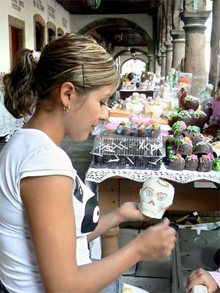
|  |  |  Travel & Outdoors | October 2008 Travel & Outdoors | October 2008  
Day of the Dead Comes to Life in Mexico
 Carol Pucci - Seattle Times Carol Pucci - Seattle Times
go to original


| | Veronica Flores Guzman of Pátzcuaro, Mexico, decorates a skull made of sugar. The skulls sell for about $1.75 and are used to decorate homes during Day of the Dead celebrations. (Carol Pucci/Seattle Times) | | |
Nowhere is the Day of the Dead celebrated more enthusiastically than in Pátzcuaro, a 16th-century town in Mexico.

Pátzcuaro, Mexico In the United States, we celebrate Halloween on Oct. 31, but one of the biggest holidays of the year in Mexico falls on Nov. 1, the Day of the Dead, when many people believe their deceased loved ones pay them a visit.

Nowhere is the day celebrated more enthusiastically than here in Pátzcuaro, a 16th-century town of about 45,000 about 225 miles west of Mexico City in the state of Michoacán.

Day of the Dead originated with the Tarascan Indians, the area's largest indigenous population. The group still has many descendants here, and this week the main plaza is lined with tables filled with sugar and chocolate offerings that people are buying to decorate graves, homes and businesses. The creativity is endless There's everything from gumballs shaped like eyeballs to skulls in all sizes; miniature plates of candy tacos; papier-mâché skeletons; even tiny, sugar-spun coffins with a skeleton inside that rises from the dead when you pull a string.

Decorating skulls made of white sugar is akin to painting on a blank canvas. Artists use colored icing and sequins to give each skull its own personality.

Mexicans see nothing morbid in any of this. The days leading up to Nov. 1 are filled with excitement and preparations. On Oct. 31, families will hire boats to go to and from Janítizio, an island in nearby Lake Pátzcuaro, to decorate grave sites. Normally Pátzcuaro is filled with tourists this time of the year, but the downturn in the American economy is taking its toll, and last week the town was practically empty.

"Last year at this time we were very, very busy," said a waiter at Cha, Cha, Cha, a popular restaurant with outdoor patios filled with plants and palm trees. "Now there's nobody."

Hotels almost everywhere are hurting even though Mexico represents one of the few travel bargains for Americans. The U.S. dollar is worth about 30 percent more against the peso than it was a few months ago, and even splurges are affordable.

After a five-hour bus ride from Mexico City, I walked into the Casa Encantada, in a 17th-century mansion off the main square, and was offered a spacious room with a fireplace, television and breakfast for about $90. Dinner at Cha, Cha, Cha chicken mole with rice and green beans and a glass of red wine was $18.

Carol Pucci: cpucci(at)seattletimes.com |

 |
|  |



